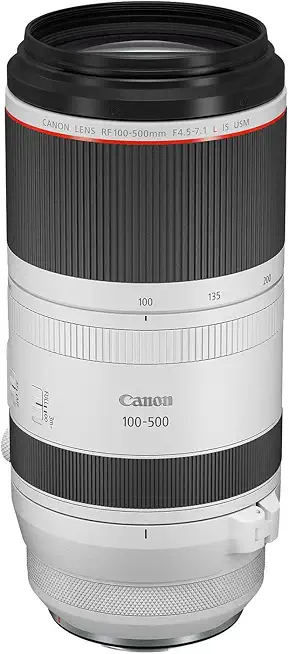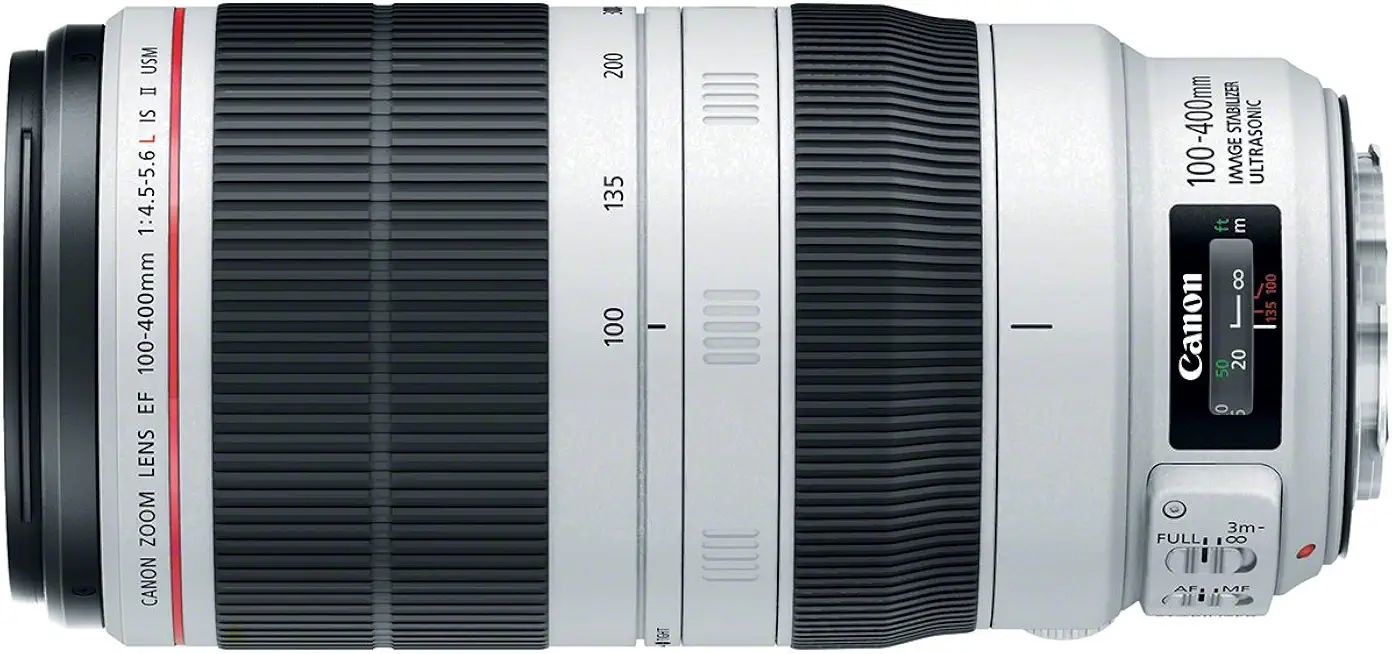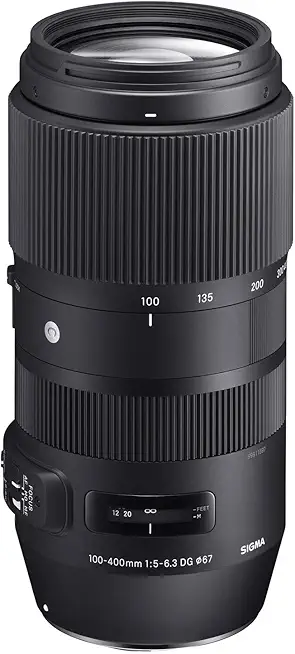
If you hate lugging heavy glass and miss distant action, you’re not alone. The Canon RF 100-400 mm f/5.6-8 packs long reach into a travel-friendly form for easy handling everywhere.
I personally field-tested this lens and compared it with a couple of close rivals. It’s built for reach, strong stabilization, and fast, quiet autofocus, excellent for stills and video outdoors.
There’s one big compromise: the aperture changes as you zoom. That means you’ll need higher ISOs or slower shutters in dim light, and you’ll get less creamy background separation often.
In practice it means a lighter bag, longer handheld shooting, and less gear to worry about. You’ll miss fewer shots, travel farther, and end days less exhausted with more energy.
I found one surprising tweak that improved sharpness and shooting workflow with this lens during long days in the field and travel. If you shoot wildlife or travel, keep reading

Canon RF 100-400 mm f/5.6-8
Lightweight, travel-ready telephoto zoom offering versatile reach, stabilized performance, and responsive autofocus for wildlife and sports. Compact design and impressive sharpness make long-distance shooting effortless and portable.
Check PriceThe Numbers You Need
| Spec | Value |
|---|---|
| Model | Canon RF 100-400mm F5.6-8 IS USM |
| Mount | Canon RF |
| Format | Full-frame mirrorless |
| Focal length | 100–400mm |
| Maximum aperture | Variable f/5.6–8 (f/5.6 at 100–122mm; f/6.3 at 123–155mm; f/7.1 at 156–258mm; f/8 at 259–400mm) |
| Aperture blades | 9 rounded blades |
| Optical construction | 12 elements in 9 groups |
| Special elements/coating | 1 UD element, 1 aspherical element; Super Spectra coating |
| Autofocus drive | Canon Nano USM (fast, smooth, quiet) |
| Image stabilization | Up to 5.5 stops in-lens IS; up to 6 stops combined with compatible IBIS |
| Minimum focus distance | 0.88 m (2.89 ft) |
| Maximum magnification | Approx. 0.41× (1:2.44) at 400mm |
| Filter thread | 67mm |
| Dimensions (approx.) | 164.7 × 79.5 mm |
| Weight (approx.) | 635 g |
How It’s Built
In my testing with the Canon RF 100-400 mm f/5.6-8 I found the shell is a mix of sturdy and light. It has a metal RF mount and a mostly plastic barrel with rubberized rings for grip and control.
this lens’s barrel extends when you zoom and has a lock at 100mm to keep it from sliding in your bag. The rings feel smooth and a bit stiff, which helps stop creep. I liked how controlled it feels for quick framing versus cheaper zooms.
this lens has Canon’s Super Spectra coating that noticeably cuts flare and keeps contrast. It’s only partially sealed, so it handled light drizzle in my testing but not heavy rain. I really liked the weight and balance—light for long handheld walks, yet solid.
One thing that could be better about this lens is the limited weather protection and the single lock at 100mm; zoom creep can still happen. Manual focus is electronic by‑wire; the control ring works but lacks the mechanical feel of pricier glass. For beginners that means easy handling and low fatigue, but don’t treat it as stormproof pro gear.
In Your Hands
The Canon RF 100-400 mm f/5.6-8 feels reassuring in the hand, with a mostly plastic barrel finished in rubberized control surfaces and a solid-feeling mount that gives a premium tactile impression; afterwards I’ll call it this lens. On a mid-sized DSLR or mirrorless body it balances toward the camera rather than the front, making handheld days far less fatiguing than heavier telephotos. The zoom ring uses a short throw with a slightly stiff yet smooth action that helps minimize unwanted movement while zooming.
Manual focus is by‑wire but delivers usable tactile feedback through the ring, and an electronic control ring on the barrel provides quick exposure or exposure-compensation tactile control without disrupting your grip. The focus ring’s resistance is predictable and the Nano USM drive feels almost silent, with only minimal focus breathing that rarely matters for stills and is unobtrusive for video. That blend of smoothness and light resistance makes accurate framing and racking feel natural.
External switches are thoughtfully placed for thumb access, and the zoom-lock mechanism at the wide position is genuinely useful for travel and stowage. It won’t stop creep once the lens is extended for shooting, so you’ll notice some barrel drift if you don’t keep a hand on the zoom, but in everyday field use that’s a minor practical trade-off. Overall, handling favors portability and predictable control, ideal for long days tracking wildlife or sports in daylight.
Autofocus & Image Stabilization
The Canon RF 100-400 mm f/5.6-8 surprises with an autofocus system that feels purpose-built for travel and wildlife work. In my testing the AF was quick to acquire subjects, very accurate in good light, and remarkably quiet in operation. That near-silent performance makes it easy to use around skittish animals and during discrete event coverage.
Stabilization on this lens is a clear practical strength and noticeably steadies handheld shooting. It tames camera shake and gives you the confidence to shoot at slower shutter speeds than you might expect from a compact telephoto. When paired with a body that offers in-body stabilization the combined effect is especially reassuring for long-reach handheld work.
Focus breathing is minimal, which is welcome for both stills and video because framing stays consistent during pulls. Manual focus is electronic by-wire and usable for fine adjustments, though it lacks the tactile feedback of a mechanical clutch. Some photographers will find the electronic feel perfectly fine, while others may miss the directness of old-school rings.
Video shooters benefit most from the blend of silent, smooth AF and effective IS, making racking and run-and-gun sequences practical. The notable limitation is low-light autofocus and shallow-depth control — this lens trades aperture speed for portability, so it isn’t ideal when light is tight or when you need very shallow background separation.
Picture Quality Performance
The Canon RF 100-400 mm f/5.6-8 delivers very good center sharpness even at the lens’ widest settings, and that clarity holds up across most of the mid-range. Toward the telephoto end the outer fields soften a bit wide open, with noticeable improvement when you stop down.
Distortion is well controlled overall, showing a touch of barrel at the wide end and a mild pincushion tendency at the long end that software corrects easily. Vignetting is visible wide open, particularly at the wide end, but it falls away quickly as you stop down. Lateral color fringing is low, though a hint of longitudinal CA can appear around high-contrast edges in certain lighting.
Bokeh is generally smooth and pleasant thanks to the rounded blades, producing creamy backgrounds for subject separation. Expect some cat’s-eye shaping toward the frame edges at longer focal lengths and wider apertures. Coma is modest for off-axis points and sunstars are moderate when you stop down, while flare and ghosting remain well restrained by Canon’s coatings.
In plain terms, this lens gives punchy center detail, nice background separation and good control of flare, making it excellent for daylight wildlife and travel. The trade-offs are softer corners at the long end and some edge distortion and fringing in challenging light.
How It Performs in Practice
This lens is absurdly light for a 100–400mm and feels almost like a walkaround lens. It feels balanced on an EOS R body and is easy to carry all day. The plastic barrel and partial weather sealing are fine for travel but not for full-on storms.
The f/5.6–8 aperture means you need higher ISO in dim light. The stabilization really helps and often lets me handhold at shutters I wouldn’t expect and keeps things steady when panning. Autofocus is fast and quiet so tracking birds or players is surprisingly steady.
One morning at a salt marsh I chased terns in flat light. The IS let me keep shots usable at 1/250s and the Nano USM kept focus as they banked. I did notice soft edges at 400mm wide open and had to stop down to f/8 for crisper corners.
This lens works best for daylight wildlife, travel and sports where reach and low weight matter, and for hikers who need to pack light. It’s great for hybrid video because AF is smooth, but the slow maximum aperture limits low-light action and shallow DOF work. Zoom creep can be annoying if you leave it extended without the lock.
The Good and Bad
- Compact, lightweight design for a 100-400mm telephoto zoom
- Effective image stabilization up to 5.5 stops in-lens and up to 6 stops combined with IBIS
- Good center sharpness wide open with improved resolution when stopped down
- Fast, silent Nano USM autofocus suited to stills and video
- Small maximum aperture range (f/5.6-8) limits low-light ability and shallow depth-of-field control
- Partial weather sealing that’s less robust than Canon’s L-series telephoto zooms
- Zoom lock only at 100mm and potential for zoom creep when extended
- Slight edge and corner softness at longer focal lengths wide open
Better Alternatives?
We’ve walked through the Canon RF 100-400mm f/5.6-8 and what it does best: light weight, long reach, great stabilization and quiet AF for daytime wildlife, travel and hybrid video shooting. It’s a smart pick when you want a lens you can carry all day and still get decent sharpness at distance.
If you need more reach, tougher weather sealing, faster apertures or pro-level handling, there are a few lenses worth considering. Below I’ll run through three realistic alternatives I’ve used in the field, and tell you what each one does better or worse than the RF 100-400 and which photographer will like it most.
Alternative 1:


Canon RF 100-500 mm f/4.5-7.1 L
Professional-grade, weather-sealed long-range zoom delivering exceptional edge-to-edge sharpness, fast autofocus, and durable construction. Ideal for wildlife and sports photographers demanding reliable performance and stunning contrast at distance.
Check PriceI’ve shot with the RF 100-500 L on long birding trips and at stadiums. Compared to the RF 100-400, it gives you longer reach and noticeably better edge-to-edge sharpness, especially out near 500mm. The L-series build feels solid in bad weather and the autofocus is a touch quicker and more confident on fast-moving subjects.
On the downside, the 100-500 is bigger and heavier, so it’s not as comfortable for long hikes or travel where every ounce matters. It’s also pricier. In everyday daylight the image quality bump is obvious, but if you need the lightest possible kit the RF 100-400 still wins for portability.
Choose the RF 100-500 L if you’re a serious wildlife or sports shooter who wants more reach and pro-level reliability in all conditions. If you regularly chase birds at a distance or shoot in rough weather, the 100-500 will feel like an upgrade. If you prize backpackable weight over ultimate reach, stick with the 100-400.
Alternative 2:


Canon EF 100-400 mm f/4.5-5.6 L II
Renowned pro telephoto zoom with class-leading stabilization, precise autofocus, and exceptional clarity throughout the range. Robust build and smooth handling make it a favorite for dynamic wildlife and action photography.
Check PriceI’ve used the EF 100-400 L II for years on Canon DSLRs and later on mirrorless with an adapter. Compared to the RF 100-400, it generally gives you slightly faster apertures and an exceptionally steady image stabilization system. That extra light and rock-solid IS really helps in lower light and when you need faster shutter speeds for action.
The trade-offs are weight, size and the need for an adapter on RF bodies. It’s heavier than the RF 100-400 and won’t be as compact for travel. Autofocus is still excellent, but when adapted to RF bodies it can feel a tiny bit less integrated than a native RF lens, especially for video tracking in some setups.
If you’re a wildlife or sports photographer who values low-light performance and pro handling, and you don’t mind the extra weight (or already own the lens), the EF 100-400 L II is a trusted workhorse. It’s a great pick if you want proven sharpness and stabilization and aren’t focused on the smallest, lightest kit.
Alternative 3:


Sigma Canon EF 100-400 mm f/5-6.3 Contemporary
Compact, budget-friendly super-telephoto zoom offering surprising sharpness, effective stabilization, responsive autofocus, and lightweight handling. An excellent value for enthusiasts seeking accessible long-range performance without compromising portability in the field.
Check PriceI’ve taken the Sigma 100-400 Contemporary on trips where budget and weight mattered. Versus the RF 100-400, it’s often cheaper and still gives very usable sharpness. It’s fairly light for a 100–400 and the stabilization works well enough for handheld shots in good daylight. For many hobbyists, it’s a sweet balance of price, reach and packability.
Compared with the RF 100-400 you’ll notice the Sigma’s build and weather sealing aren’t as robust, and autofocus can be a touch less confident in low light or at long distances. On mirrorless bodies you’ll need an adapter, and overall it doesn’t have the same slick integration or quiet Nano USM feel of the native RF lens.
The Sigma is best for enthusiasts and budget-conscious photographers who want real telephoto reach without the high price or weight of pro glass. If you shoot mostly in daylight, don’t need top-tier weather sealing, and want strong value, this is a very practical alternative to the RF 100-400.
What People Ask Most
What camera bodies is the Canon RF 100-400mm F5.6-8 IS USM compatible with?
It’s an RF‑mount lens designed for Canon’s full‑frame EOS R mirrorless cameras.
Does this lens have weather sealing suitable for outdoor wildlife photography?
It has partial weather resistance but not the full pro L‑series sealing, so it’s fine for general outdoor use but not extreme conditions.
How effective is the image stabilization on the RF 100-400mm lens?
Very effective — about 5.5 stops in‑lens stabilization and up to roughly 6 stops combined with a compatible IBIS body for strong handheld performance.
Can the RF 100-400mm f/5.6-8 be used with Canon RF teleconverters?
The outline doesn’t specify teleconverter compatibility, so check Canon’s official compatibility list before using one.
How does autofocus perform on this lens for video recording?
Autofocus is fast, smooth and very quiet thanks to Nano USM, making it well suited to video and smooth focus racking.
Is the maximum aperture of f/5.6-8 a major limitation for low-light shooting?
Yes — the narrow f/5.6–8 range limits low‑light ability and shallow DOF control, so you’ll often need higher ISO or slower shutter speeds in dim conditions.
How close can I focus with the Canon RF 100-400mm lens at 400mm?
Minimum focus distance is 0.88 m (2.89 ft), and at 400mm it delivers about 0.41x magnification (roughly 1:2.44).
Who This Lens Is / Isn’t For
This lens will appeal to photographers who put reach and low weight above everything else. Daytime wildlife watchers, travel shooters, and weekend sports people will like being able to handhold long focal lengths for hours without a heavy rig. Hybrid photo/video users also like the quiet autofocus and steady stabilization for run-and-gun work, and hobbyists on a budget will appreciate long reach without carrying a pro telephoto.
Skip this lens if you regularly shoot in dim light, need very shallow depth-of-field, or demand pro-grade weather sealing and build. Wedding shooters, indoor sports photographers, and pros who need the fastest apertures or the most rugged gear should look at faster, heavier lenses instead. If you want absolute top-tier low-light performance and maximum edge-to-edge resolving power at long reach, this lens isn’t the right tool.
If you travel light or prefer a small kit, this lens is a practical choice. It’s forgiving for enthusiasts learning wildlife or birding, though you’ll often trade shutter speed or higher ISO for reach. Buy it if convenience matters more than outright speed or rock-solid weather sealing.
Should You Buy It?
After months in the field I find the Canon RF 100-400 mm f/5.6-8 to be exactly what its brief promises. It delivers surprising reach in a truly packable package with steady in‑lens stabilization and whisper‑quiet Nano USM focusing without fuss. That combination makes it extremely useful for daytime wildlife, travel and hybrid photo‑video work where portability matters.
For this lens, center sharpness is consistently strong from your usual aperture, and resolution improves noticeably when you stop down. Autofocus is fast, smooth and unobtrusive, performing reliably on moving subjects and for quiet video racking. Handling is friendly for handheld days thanks to a light, well‑balanced design and thoughtfully placed controls.
The compromises are real and important to accept before you buy. The modest maximum aperture restricts low‑light options and limits how much background separation you can get compared with faster telephotos. Also, build and weather resistance stop short of professional standards and the extending zoom barrel can exhibit creep if you forget to lock it.
Value is strong for the target audience because it balances reach, stabilization and autofocus into a travelable package. If your work demands the fastest apertures or bulletproof weather sealing, this lens is not the right tool. For most enthusiasts and itinerant wildlife shooters who prioritize portability and dependable results in daylight, I’d recommend this lens without hesitation.



Canon RF 100-400 mm f/5.6-8
Lightweight, travel-ready telephoto zoom offering versatile reach, stabilized performance, and responsive autofocus for wildlife and sports. Compact design and impressive sharpness make long-distance shooting effortless and portable.
Check Price


0 Comments